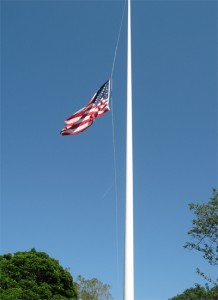
When Francis Scott Key wrote the Star Spangled Banner, it was because he was inspired. Through bombs bursting over Fort McHenry in Baltimore, he watched from a distant ship and waited for a sign that the British had not defeated the Americans. For twenty-five hours he waited, until finally “through the dawn’s early light” he saw a sign of hope. The flag–then consisting of 8 red and 7 white stripes, and 15 stars–still waving. Tall. Strong. Free. He took a letter from his pocket and wrote the poem on the back that would become the American National Anthem.
Whenever I see the American flag, I have often thought of his words. The poem sums up what our flag should represent; a celebration of not just survival, but our ability to thrive. The flag is a promise. At full-staff, and even half-staff. When I have seen a flag at half-staff, I’ve often wondered “whose life are we celebrating today?” Which long-term giver, social-reformer, or public official has died who helped make America better?
But not lately.
Now when I see a flag at half-staff, I worry. “What happened?” “What tragedy will I see on the news now?” I have seen our flag too often at half-staff, and it saddens me. Has our flag become a signal not of hope, but of our failures? Does it represent lives cut short? Terror? Immense grief for more Americans unable to fulfill the promise and the freedom our veterans helped to secure?
We can do better. We must do better.
So on this flag day, I’ll hope you’ll share the full poem by Francis Scott Key with your family. Tell them the story. I hope we as a nation can focus on the fact it should fly “o’er the land of the free and the home of the brave?” We can not simply sing the words. Our actions must raise our flag until it is gallantly streaming.
